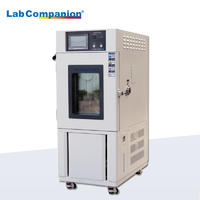Email Us :
info@lab-companion.com labcompanionltd@gmail.com-

-

Requesting a Call :
+86 18688888286
One reason 1. Because the temperature of the constant temperature and humidity test chamber cannot be maintained, observe whether the refrigeration compressor can start when the test chamber is running, and whether the compressor can start when the environmental test equipment is running, indicating that the circuit from the main power supply to each compressor is normal and the electrical system has no problem.
2. There is no fault in the electrical system. Continue to check the refrigeration system. First, check whether the exhaust and suction pressure of the low temperature (R23) compressor of the two sets of refrigeration units are lower than the normal value, and whether the suction pressure is in the vacuum state, indicating that the refrigeration dose of the main refrigeration unit is insufficient.
3. Touch the exhaust pipe and suction pipe of the R23 compressor with your hand, and find that the temperature of the exhaust pipe is not high, and the temperature of the suction pipe is not low (no frost), which also indicates that the R23 refrigerant in the host is insufficient.
Another reason: 1. The cause of the failure has not been determined, and further confirmation is made in combination with the control process of the constant temperature and humidity test chamber. The test chamber has two sets of refrigeration units.
One is the main unit, and the other is the auxiliary unit. When the cooling rate is high, both units operate simultaneously at the beginning of the temperature maintenance phase. Once the temperature stabilizes, the auxiliary unit stops, and the main unit maintains the temperature. If the R23 refrigerant leaks from the main unit, its cooling efficiency will be significantly reduced. During the cooling process, both units operate simultaneously, ensuring stable temperatures and a gradual decrease in cooling rate. In the insulation phase, if the auxiliary unit stops, the main unit loses its cooling function, causing the air inside the test chamber to rise slowly. When the temperature reaches a certain level, the control system activates the auxiliary unit to cool down, after which the auxiliary unit stops again. The cause of the production failure has been identified as a low-temperature (R23) refrigerant leak from the main unit. Upon checking the refrigeration system for leaks, a crack was found on the valve stem of the hot gas bypass solenoid valve, measuring about 1cm in length. After replacing the solenoid valve and recharging the system with refrigerant, the system returned to normal operation. This analysis shows that the fault diagnosis follows a step-by-step approach, starting from the 'external' aspects and moving inward, then focusing on 'electricity' and finally on 'cooling.' A thorough understanding of the test chamber's principles and operational processes is essential for accurate fault diagnosis.
